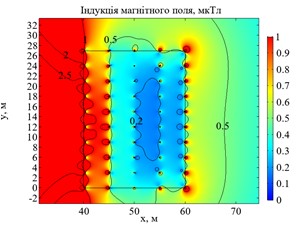Моделювання ґратчастого багатошарового екрану для зниження магнітного поля ліній електропередачі
Основний зміст сторінки статті
Анотація
Блок інформації про статтю

Ця робота ліцензується відповідно до Creative Commons Attribution 4.0 International License.
Автори, які публікуються у цьому журналі, погоджуються з наступними умовами:- Автори залишають за собою право на авторство своєї роботи та передають журналу право першої публікації цієї роботи на умовах ліцензії Creative Commons Attribution License, котра дозволяє іншим особам вільно розповсюджувати опубліковану роботу з обов'язковим посиланням на авторів оригінальної роботи та першу публікацію роботи у цьому журналі.
- Автори мають право укладати самостійні додаткові угоди щодо неексклюзивного розповсюдження роботи у тому вигляді, в якому вона була опублікована цим журналом (наприклад, розміщувати роботу в електронному сховищі установи або публікувати у складі монографії), за умови збереження посилання на першу публікацію роботи у цьому журналі.
- Політика журналу дозволяє і заохочує розміщення авторами в мережі Інтернет (наприклад, у сховищах установ або на особистих веб-сайтах) рукопису роботи, як до подання цього рукопису до редакції, так і під час його редакційного опрацювання, оскільки це сприяє виникненню продуктивної наукової дискусії та позитивно позначається на оперативності та динаміці цитування опублікованої роботи (див. The Effect of Open Access).
Посилання
A. Giorgi, R. Conti, R. Rendina, L. Sartore and E. Sena, "Technical Solutions To Reduce 50 Hz Magnetic Fields from Power Lines," in Proceedings of Power Tech Conference IEEE’2003, 23-26 June, 2003, Bologna (Italy), 2003.
M. Feychting, B. Floderus and A. Ahlbom, "Parental occupational exposure to magnetic fields and childhood," Cancer Causes and Control, vol. 11, no. 2, pp. 151-156, 2000.
V. Yu. Rozov, S. Yu. Reutskiy, D. Ye. Pelevin, O. Yu. Pyliugina, "Magnitnoe pole linij elektroperedachi i metody ego snizheniya do bezopasnogo urovnya [The magnetic field of power transmission lines and the methods of its mitigation to a safe level]," Tekhnichna elektrodynamika, no. 2, pp. 3-9, 2013. URL: http://techned.org.ua/2012_2/st8.pdf
D. Ye. Pelevin, "Ekranirovanie magnitnogo polya promyshlennoj chastoty stenami zhilyh domov [Screening magnetic fields of the power frequency by the walls of houses]," Elektrotekhnika i Elektromekhanika, no. 4, pp. 53-55, 2015. DOI: 10.20998/2074-272X.2015.4.10
A. O. Pavlushko, A. V. Dymerets, A. V. Krasnozhon, "Matematychne modeliuvannia parametriv elektromahnitnoho polia diiuchoi PL 330 kV [Mathematical modeling of electromagnetic field parameters of the overhead power line 330 kV]," in Vseukrainska naukovo-praktychna konferentsiia «Novitni Tekhnolohii Suchasnoho Suspilstva» NTSS-2019, Chernihiv, Ukraine, 2019.
M. Sh. Misrihanov, A. Yu. Tokarskiy, "Preimushestva i nedostatki prostyh kompaktnyh vozdushnyh linij elektroperedachi [Advantages and disadvantages simple compact overhead power lines]," Povyshenie effektivnosti raboty energosistem, pp. 204-223, 2003.
M. Sh. Misrihanov, A. Yu. Tokarskiy, "Upravlyaemye kompaktnye linii elektroperedachi [Managed compact power lines]," Trudy IGEU, no. 6, pp. 238-248, 2003.
S. Celozzi, F. Garzia, "Active shielding for power-frequency magnetic field reduction using genetic algorithms optimization," IEE Proceedings – Science, Measurement and Technology, vol. 151, no. 1, pp. 2-7, 2004.
B. I. Kuznetsov, T. B. Nikitina, A. V. Voloshko, I. V. Bovdyj, E. V. Vinichenko, B. B. Kobilyanskiy, "Sintez sistem aktivnogo ekranirovaniya magnitnogo polya vozdushnyh linij elektroperedachi na osnove mnogokriterialnoj optimizacii [Synthesis of an active shielding system of the magnetic field of power lines based on multiobjective optimization]," Elektrotekhnika i Elektromekhanika, no. 6, pp. 26-30, 2016. DOI: 10.20998/2074-272X.2016.6.05
J. Burnett, P. Du Yaping, "Mitigation of extremely low frequency magnetic fields from electrical installations in high-rise buildings,". Building and Environment, vol. 37, no 8-9. pp. 769-775, 2002. DOI: 10.1016/S0360-1323(02)00043-4 .
M. De Wulf, P. Wouters, P. Sergeant, L. Dupreґ, E. Hoferlin, S. Jacobs, P. Harlet, "Electromagnetic shielding of high-voltage cables," Journal of Magnetism and Magnetic Materials, no 316, pp. 908-911, 2007. DOI: 10.1016/j.jmmm.2007.03.137
M. M. Rezinkina, V. S. Grinchenko, " Elektromagnitnye ekrany dlya snizheniya indukcii magnitnogo polya promyshlennoj chastoty na obektah energetiki [Usage of electromagnetic shields for power frequency magnetic field mitigation in power industry]," Tekhnichna elektrodynamika, no. 3, pp. 15-16, 2012. URL: http://techned.org.ua/2012_3/st5.pdf
D. Bavastro, A. Canova, F. Freschi, L. Giaccone, M. Manca, "Magnetic field mitigation at power frequency: design principles and case studies," IEEE Transactions on Industry Applications, vol. 51, no 3, pp. 2009-2016, 2015. DOI: 10.1109/TIA.2014.2369813
A. Canova, D. Bavastro, F. Freschi, L. Giaccone, M. Repetto "Magnetic shielding solutions for the junction zone of high voltage underground power lines," Electric Power Systems Research, no 89. pp. 109-115, 2012. DOI: 10.1016/j.epsr.2012.03.003
P. L. Cruz Romero, J. C. Del-Pino-Lуpez, "Magnetic field shielding of underground cable duct banks," Progress In Electromagnetics Research, no 138, pp. 1-19, 2013.
М. М. Rezinkina, А.А. Shcherba, V.S. Grinchenko, K.O. Rezinkina, "Raschetnyj vybor parametrov elektromagnitnyh ekranov slozhnoj prostranstvennoj konfiguracii [Calculation choice of parameters of electromagnetic screens of complicated three-dimensional configuration]," Tekhnichna elektrodynamika, no. 1, pp. 10-16, 2012. URL: http://techned.org.ua/2012_1/st2.pdf
E. Salinas, M. Rezinkina, J. Atalaya, "Some 2D–3D aspects of shielding of longitudinal sources of extremely low frequency magnetic fields," The Environmentalist, vol. 29, no 2, pp. 141-146, 2009. DOI: 10.1007/s10669-008-9206-0 .
V. S. Grinchenko, "Znyzhennya mahnitnoho polya tryfaznykh liniy elektroperedachi hratchastym elektromahnitnym ekranom [Mitigation of three-phase power line magnetic field by grid electromagnetic shield]," Tekhnichna elektrodynamika, no. 4, pp. 29-32, 2018. DOI: 10.15407/techned2018.04.029
D. N. Shapiro, Basis of electromagnetic screening, Leningrad: Energiia, 1975, 109 p.





